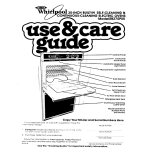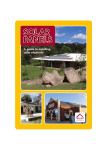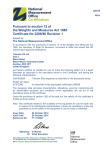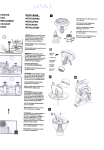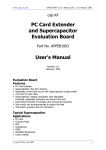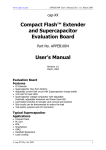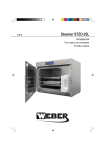Download Siemens SP65 Installation guide
Transcript
SIEMENS GENERAL INSTALLATION GUIDE for Siemens Solar Electric Modules 1. INTRODUCTION This Guide contains application and safety information with which you should be familiar before using your Siemens Solar photovoltaic modules. authorized Siemens Solar Your distributor or dealer can provide additional sizing and system design information if necessary. assemblies. All modules come with a permanently attached junction box that will accept a variety of wiring applications or with a special cable assembly for ease of installation. 411 instructions should be read understood before snd mttempting to install, wire, maintain the Dperate and photovoltaic module. Contact with electrically active paris of the module such as terminals can result in burns, sparks, and lethal shock whether the module is connected or disconnected. Since the use of this Guide and the conditions or methods of installation, operation, use and maintenance of the module are beyond Siemens Solar control, Siemens Solar does not assume responsibility and expressly disclaims liability for loss, damage, or expense arising out of or in any way connected with such installation, operation, use or maintenance. No responsibility is assumed by Siemens Solar for any infringement of patents or other rights of third parties which may result from use of the module. Photovoltaic modules produce electricity when sunlight or other sources illuminate the front face. The voltage from a single module is not considered a shock hazard. When modules are connected in series, voltages are additive. When modules are connected in parallel, current is additive. Consequently, a multimodule system can produce high voltages and current which constitute an increased hazard and could cause serious injury 01 death. No license is granted by implication or otherwise under any patent or patent rights. The information in this Guide is based on Siemens Solar knowledge and experience and is believed to be reliable; but such information including specifications (without product limitations) and suggestions do not constitute a warranty, expressed or implied. Siemens Solar reserves the right to make changes to the product, specifications, or Guide without prior notice. The installation of solar modules requires a great degree of skill and should (if DC voltage exceeds IOOV: must) only be performed by a qualified including, professional, licensed without limitation, licensed contractors and licensed electricians. The installer assumes the risk of all injury that might occur during installation, including, without limitation, the risk of electric shock. Siemens Solar modules do not require the use of special cable Part No. (019831) REV. E l WARNING Disclaimer of Liability General Information . . . . . . . . . . CA UT/O/W . Avoid electrical hazards when installing, wiring, operating and maintaining the module. A phofovolfaic module generates DC electricity when exposed to sunlight or other light sources. When installing or working with module or wiring, cover module face completely with opaque m a t e r i a l to halt production of electricity. If i s r e c o m m e n d e d t h a t t h e module remains packed in the box until time of installation. Do not touch terminals while module is exposed to light or during installation. Provide suitable guards to prevent contact with 30VDC or greater. As an added precaution, use properly insulated tools only. Do not drop module or allow objects to fall on module. Do not stand or step on module. It must be assured that other components do not system generate any hazard of any mechanical or electrical nature to the module. Since sparks may be produced, do where not install module flammable gases or vapors are present. Never leave a module unsupported or unsecured. If a module should fall, the glass can A module with broken break. glass cannot be repaired and must not be used. Work only under dry conditions, with dry module and tools. Module installation and operation should be performed by qualified personnel on/y. Children should not be allowed near the solar electric installation. If not otherwise specified, if is recommended that requirements of the latest local, national or codes be regional electric followed, Use module for its intended function only. Follow all module manufacturer’s instructions. Do not dis-assemble the module, or remove any part or label installed by the manufacturer. Do not treat the back sheet with paint or adhesives. Do not artificially concentrate sunlight on the module. Retain this instruction booklet for future reference. The word “module” as used in this Guide refers to one or m o r e photovoltaic modules. 1 2. GENERAL SAFETY Follow All Permit, Ins talla tion and Inspection Requirements . . . . . . Before installing module, contact appropriate authorities to determine permit, installation and inspection requirements that should be followed. This should be done not only for installations in conjunction with buildings, but also for marine and motor vehicle applications for which additional requirements may apply. Electrically ground module(s) for all systems of any voltage (US only). If not otherwise specified, it is recommended that the latest National and International Electrical Code requirements be followed. For roof mounted modules, special construction m a y b e required to help provide proper installation. Both roof construction and module installation design have an effect on the fire resistance of the building. Improper installation may contribute to hazards in the event of fire. Additional devices such as ground fault, fuses and disconnects may be required. Do not use modules of different configurations in the same system. Follow all safety precautions of other used components. Underwriters Laboratory Listing Information (US Only): To satisfy the conditions of the UL Listing when installing the modules, be sure to: 1. Use only stranded or solid copper single-conductor type UF cable, rated sunlight resistant, for modules and module wiring that is exposed to weather. 2. Observe the requirements described by note under Electrical Characteristics. 3. Grounding of module frame is required. When ground wires greater than No. 10 AWG are required, the installer will need to provide suitable terminal connectors to interface with the No.10 binding screw provided with each module. 3. INSTALLATION Modules should be firmly fixed in place in a manner suitable to withstand all expected loads, including wind and snow loads. Part No. (019831) REV. E Modules should be mounted with the orientation and tilt angle required for optimum performance (seasonally, yearly). The location should be selected to prevent even partial shading from 9:00 a.m. to 3:00 p.m. (solar time) on the shortest day of the year. Generally, the tilt angle can be calculated by using the site latitude plus 20 degrees, with modules facing south in the northern latitudes and north in the southern latitudes. The mounting structure must withstand all snow and wind forces. Mounting holes are provided for easy installation and proper mechanical loading. Do not drill additional mounting holes in the module frame as it will void the warranty. The use of proper mounting hardware is recommended to minimize the possibility of corrosion of the module frame, mounting structure and hardware. Installing a laminate (module without frame) use Siemens module clamps. Contact your local dealer for . _ lntormation reaardina sDecial mounting irofilei -’ -for modules and laminates. -CR junction box - Do not connect more than four modules in parallel. Caution Most of the module types contain factory installed bypass diodes. If these modules are incorrectly connected to a battery, the bypass diodes and junction box may be damaged. Observe correct polarity: . Positive wire from module to regulator or battery positive terminal . Negative wire from module to regulator or battery negative terminal Array Wiring The term “array” is used to describe the assembly of several modules on a support structure with associated wiring. Use copper wire that is sunlight resistant and is insulated to withstand the maximum possible system open circuit voltage. Check your local codes for requirements. Figure 8 Series and parallel wiring Series wiring will increase voltage Caution Clearance between the module frame and the mounting surface is required to allow cooling air to circulate around the back of the module. This also all0 ws any condensation or moisture to dissipate. The module should never be sealed to the mounting surface with sealant that prevents air from circulating under the module. 4. WIRING General All wiring should be done in accordance with applicable codes. Wiring should be protected to help ensure personal safety and to prevent its damage. Wiring connectors should be mechanically and electrically sound. For connection to a battery, we recommend the use of a charge regulator (except SM46 and SM20). All modules connected in series should be of the same model number/type. However, modules of different model numbers/types may be connected in parallel (see figure 8). Modules with the ProChargerTM Parallel wiring will increase current Earth Ground Wiring Each framed module has a hole in the side frame rail for connection of a ground wire. A No. IO binding screw and washer is provided with each module (not included with the SM110/SM100 module) to connect a ground wire to the module metal frame. US only: This assembly must be performed for a safe and proper installation. Other accessories provided are for optional use. To install ground wire, first install screw with cup washer partially into hole. If the wire is insulated, strip insulation back approximately 5/8” (16mm) from the end of the wire and wrap wire around screw between its head and the cup washer. Tighten screw. The cup washer may be omitted if the wire is provided with a terminal lug. The ground wire should also be attached to the support structure. 2 Module Terminations The are four types of terminal electrical enclosures used for connections on Siemens modules. In addition, wire is also used to provide for electrical connections. Refer to figures 1 through 7 to determine which type of connection is provided with your module. 4.1 Wiring Modules with a Single ProChargerTM-CR Junction Box General Wire terminals are accessible by removing the j-box lid. Remove the lid by loosening its two captive screws with a small flat or Phillips screwdriver. Wire size must range from 1.5 mm2 to 10 mm2 (8 AWG to 14 AWG). The use of wire lugs is not required or recommended, but is possible. Once wiring is complete, install the j-box lid and tighten both screws to 0.5 - 0.7 Nm (4 - 6 in-lb). J-box configuration and description of terminals Modules equipped with one j-box, contain terminals for both positive and user-selectable negative polarity, 6V/l2V voltage wiring and by-pass diodes. Refer to Figure 1 for terminal description. Figure 1 - Modules with Single ProChargerTM -CR J-Box Description of Terminals Internal wiring terminals with: - connection to solar cells - bypass diodes - jumper(s) See figure 9 for voltage selection stripped wire into knockout hole and pierce through foam seal. An awl or other sharp tool can be used to pierce Feed through the foam seal. appropriate length of wire to reach User-interface wiring terminal screw. Insert stripped wire (external) between terminal plate and square terminals screw washer. Figure 9 Selection of operating voltage Tighten screw to 2.3 Nm 120 in-lb). mounting posts after completion of a repair. The schematics engraved in this cover remind the user of the correct wiring for 6V options. Liquid-tight I/2” fitting (NPT 4”) Remove knockout plug with screw-driver placed close to perimeter rim Bypass diodes not required impact and driver with hammer. Use of The j-box provides six IO-32 terminal a UL recognized liquid-tight l/2” fitting screws for external wiring of the is required to seal and strain relief the module. Two terminals are dedicated wire/cable installed. Follow the fitting to each polarity (with the polarity manufacturer’s recommendations for symbols engraved into the j-box floor). installation and use. Install fitting on Two spare terminals (i.e. floating, not box but leave it loose. Feed the wire connected to the module circuit) can be through fitting and route it to terminal used for other applications such as screw. Connect wire as described blocking diodes. above. Complete tightening of the liquid-tight fitting. Wire entry and connections There are three methods of wire entry Conduit to the j-box. Refer to Figure 2. For applications where wire conduits are used, follow the applicable codes for outdoor installation of wires in Figure 2 - Wire Feedconduits. Verify that all fittings are through Options properly installed to secure wires ProChargerm -CR J-Box against damage and prevent moisture Following conduit intrusion. installation and wire length adjustment, connect wire as described above. 3ypass diodes note direction) 12V jumper / 6V jumpers provided in installation kit (jumpers must not touch each other) Strain Relief No additional wire strain relief is required. However, it is recommended that strain relief be used to secure the wire or cable to the j-box. Two posts are provided to accept cable ties for this purpose. User-interface terminals with: - (2) positive terminals (+I - (2) negative terminals (-1 - (2) isolated or spare term Internal wiring of module and voltage selection Terminals for internal wiring of module and voltage selection are adjacent to the slotted opening at the j-box bottom and protected with a small cover. These terminals are factory-wired with interconnection to the solar cell ribbons and by-pass diodes for 12 V D C User does not need to operation. access these terminals, except for the replacement of a broken diode or to change the operating voltage of the module. Figure 9 describes the wiring for selecting the desired operating voltage. The cover is a diode shield and must be placed back on its Part No. (019831) REV. E 1 f2” Liquid tight fitting Direct wire penetration with elastomer seal Only one wire should be fed through each small diameter knockout. Remove knockout plug with screwdriver using Slide the rubber moderate impact. foam seal in the cavity in front of the knockouts and push it down and flat all the way with a screwdriver. Strip wire insulation to 16mm (5/8”). Insert the 4.2 Wiring Modules with Two ProChargerTM-CR Junction Boxes Modules equipped with two separate weather-protection jcontain terminals for boxes electrical connections. One j-box output positive houses the connections and the other j-box houses the negative output Both j-boxes also connections. include by-pass diodes. Refer to figure 3 for terminal description. 3 Figure 3 - Modules with two ProChargerTM -CR J-Boxes Figure 4 - Modules with Single ProChargerTM -S J-Box Positive J-Box through strain relief and under marked terminal screw slider. Check the correct polarity of wire and terminal. Tighten screw securely using a screwdriver of the proper size and check if it’s fixed. Use proper wrench to tighten the strain relief. When completed verify that the strain relief is secured correctly by pulling the cable. Upon completion of wiring, set the terminal lid in place and tighten all 4 screws. The special design of the cover eliminates the need for a gasket. Do not attempt to seal lid to box. Wire entry and connections Refer to section 4.1 “Direct Wire Penetration with Elastomer Seal”. 4.4 Wiring Modules with Two ProChargerm -S Junction Boxes Negative J-Box Modules equipped with two separate weather-protection jcontain terminals for boxes ;:;r-sat yh;nections. One j-box positive output connections and the other j-box houses the negative output connections. Both j-boxes also include by-pass diodes. Refer to figure 5 for terminal description. Figure 5 - Modules with two ProChargerTM -S JBoxes 4.6 Wiring Modules with One Sp Junction Box There is one weather protected terminal cover for positive and negative termination. Access to the terminal cover is obtained by unscrewing the 4 screws of the lid. The terminal has provision for attaching one wire for each polarity, which can range from 1.5 mm2 to 4 mm2 (12 to 16 AWG) in size. Connect wires as described above. 4.7 Wiring Modules with Wire or Cable Termination Crimped connectors are recommended. if Wires should be soldered connections are made by splicing wires together. Connections should be protected against corrosion and shortcircuiting. Warning The voltage from a single module is not considered a shock hazard. Do not install two or more modules in series to make higher voltages. Wire entry and connections There are three methods of wire entry to the j-box. Refer to Figure 2. 4.3 Wiring Modules with a Single ProChargerTM -S Junction Box General Refer to section 4.1 “General”. J-box configuration and description of terminals Modules equipped with one j-box, contain terminals for both positive and negative polarity. Refer to Figure 4 for terminal description. Part No. (019831) REV. E Wire entry and connections section “Direct Wire Refer to Penetration with Elastomer Seal”. 4.5 Wiring Modules with Two Sp Junction Boxes There are two weather protected terminal covers, one for positive termination and one for negative termination. Access to the terminal cover is obtained by unscrewing the 4 screws of the lid. Each terminal has provision for attaching one wire, which can range from 1.5 mm2 to 4 mm2 (12 to 16 AWG) in size. To install wire, first strip insulation back 16mm (5/8”). Do not lubricate wire. Insert stripped wire These small solar modules are designed for 12-volt systems only. Suggested wire sizes and lengths are as follows (longer distances require larger size wire): Model Distance Wire Size SM6/ST5 up to 25 feet SMlO/STlO up to 25 feet AWG 18 AWG 16 SM20/ST20 up to 25 feet AWG 14 4.8 Self-Regulation This information applies to modules with 30 solar cells in series (SM20 and SM46). 4 In operation, the charging current provided to the battery by this module decreases as the battery voltage increases; thus, a battery at a low state of charge will accept more charging current than one which is at or near a full state of charge, If the system is used during the will charging current the day, continuously adjust to replace the energy used. To obtain the benefit of self-regulation: Use proper minimum battery size of 1. IOOAH for each module. 2. Install the module and battery so that the air temperatures around them are similar; within 20°F (-7°C). Use the system regularly. The 3. current from a self-regulating module to a fully charged battery may overcharge the battery if the system is not used frequently. The amount of overcharge may result in undesirable consumption of electrolyte, but should not damage the batfefy. The factory-installed diodes provide proper circuit protection without the need for additional diodes in most systems. If, however, it is necessary to parallel modules within series strings, proceed as follows: Connect modules in parallel with internal bypass diodes intact and place one large external diode around the parallel group. Each external bypass diode should be properly rated and provided with a heat sink, if necessary. The external diode is required because the small internal diodes may not share current flow equally with this wiring arrangement. 6. MAINTENANCE Minimal maintenance is required to maintain optimal module performance. If the module becomes dirty, a reduction in We energy output may result. recommend the use of water and a soft cloth or sponge to clean the glass module surface. A mild non-abrasive detergent may be used on persistent contaminants. We recommend a semi-annual inspection electrical mechanical of and all connections for cleanliness, tightness and absence of damage. Protect yourself against possible electric shock during maintenance. Have a professional correct any problems found. Modules with Wire or Cable Termination Figure 6 Diode placement and polarity If it is not possible to meet these requirements, it will be necessary to use a charge regulator. nma to protact 5. DIODES Load I!? Blocking Diodes Load These devices prevent current flow from the battery to the solar module when the module is not generating electricity. The use of blocking diodes, such as a Schottkys barrier type, is recommended in most applications where diodes are required. We also recommend the use of a charge controller. The controller normally has circuitry to prevent reverse current, while protecting the battery When using a against overcharging. charge controller, a blocking diode may not be required. Contact your authorized Siemens Solar distributor or dealer for proper diode type. Refer to the wiring diagram (figures 6 & 7) for diode placement and polarity. Black Figure 7 ‘Controller/regulator placement Bad 1 Bypass Diodes Shading of individual cells and modules in series strings can cause a reverse voltage Because across the cell or module. current is forced through the shaded area by other series cells, undesirable heating can occur. The use of a diode to bypass the shaded area can minimize both heating and reduction of array current. All Siemens modules with the exception of the SM6, SMIO, SM20, ST5, STIO, ST20 and SRSO-Z incorporate factory installed bypass diodes. Part -J I FUBS to protect bad Fuse > + Battery . Black NO. (019831) REV. E 5 ____ - - 7. LIMITED WARRANTY SIEMENS SOLAR ELECTRIC (PHOTOVOLTAIC 1 MODULES Limited Warranty - One Year Repair, Replacement or Refund Remedy Siemens Solar warrants the modules to be free from defects in materials and workmanship normal under application, installation, use and service conditions. If the product fails to conform to this warranty, then for a period ending twelve (12) months from date of sale to the original consumer purchaser, Siemens Solar will, at its option, either repair or replace the product, or refund the purchase price. The repair or replacement or refund remedy shall be the sole and exclusive remedy provided under the warranty and shall not extend beyond the twelve (121 month period set forth herein. Limited Warranty - Limited Remedy For modules ST5, STIO, STZO, ST40: If, within five (5) years from the date of sale to the original consumer purchaser, any module(s) exhibits a power output less than 90% of the minimum power specified at time of delivery, then, provided that such loss in power is determined by Siemens Solar (at its sole and absolute discretion) to be due to defects in materials or workmanship, Siemens Solar will replace such loss in power by either providing to the buyer additional modules to make up the total wattage loss, or by repairing or replacing the module, at the option of Siemens Solar. Limited Warranty - Limited Remedy For modules SM6, SMlO, SM20, SP18, SP36, SM46, SMSO-H, SM50, SR50, SR50-Z, SM55, SMIOO, SMIIO, SM130, SP65, SP70 and SP75, SR90, SRIOO: If, within ten (IO) years from the date of sale to the original consumer purchaser, any module(s) exhibits a power output fess than 90% of the minimum power specified at time of delivery, then, provided that such loss in power is determined by Siemens Solar (at its sole and absolute discretion) to be due to defects in materials or workmanship, Siemens Solar will replace such loss in power by either providing to the buyer additional modules to make up the total wattage loss, or by repairing or replacing the module, at the option of Siemens Solar. For modules SM46, SMSO-H, SM50, SR50, SM55, SR90, SRlOO, SMIOO, SMI 10, SM130, SP65, SP70 and SP75: If, within twenty-five (25) years from the date of sale to the original consumer Part No. (019831) REV. E purchaser, any module(s) exhibits a power output less than 80% of the minimum power specified at time of delivery, then, provided that such loss in power is determined by Siemens Solar (at its sole and absolute discretion) to be due to defects in materials or workmanship, Siemens Solar will replace such loss in power by either providing to the buyer additional modules to make up the total wattage loss, or by repairing or replacing the module, at the option of Siemens Solar. T h e r e m e d y set forth in these paragraphs shall be the sole and exclusive remedy provided under the extended term warranty. The limited warranties set forth herein do not apply to any module which in Siemens Solar’s sole and absolute judgment has been subjected to misuse, neglect or accident, or which has been damaged through abuse, alteration, improper application, or installation or negligence in use, storage, transportation or handling, or has been repaired, or in any way tampered with by anyone other than Siemens Solar. The limited warranties do not cover any transportation costs for return of module, or for reshipment of any repaired or replaced module, or cost associated with installation, removal or reinstallation of modules. “THE LIMITED WARRANTIES SET FORTH HEREIN ARE EXPRESSLY IN LIEU OF AND EXCLUDE ALL OTHER EXPRESS OR IMPLIED WARRANTIES, INCLUDING BUT NOT LIMITED TO WARRANTIES OF MERCHANTABILITY AND OF FITNESS FOR PARTICULAR PURPOSE, USE, OR APPLICATION, AND ALL OTHER OBLIGATIONS OR LIABILITIES ON THE PART OF SIEMENS SOLAR, UNLESS SUCH OTHER WARRANTIES, OBLIGATIONS OR LIABILITIES ARE EXPRESSLY AGREED TO IN WRITING SIGNED AND APPROVED BY SIEMENS SOLAR. SIEMENS SOLAR SHALL HAVE NO LIABILITY RESPONSIBILITY OR WHATSOEVER FOR DAMAGE OR INJURY TO PERSONS OR PROPERTY, OR FOR OTHER LOSS OR INJURY RESULTING FROM ANY CAUSE WHATSOEVER ARISING OUT OF OR RELATED TO THE PRODUCT, INCLUDING, WITHOUT LIMITATION, ANY DEFECTS IN THE MODULE, OR FROM USE OR INSTALLATION. UNDER SHALL NO CIRCUMSTANCES SIEMENS SOLAR BE LIABLE FOR INCIDENTAL, CONSEQUENTIAL OR SPECIAL DAMAGES, HOWSOEVER CAUSED. SIEMENS SOLAR’S AGGREGATE LIABILITY, IF ANY, IN DAMAGES OR OTHERWISE, SHALL NOT EXCEED THE PAYMENT, IF ANY, RECEIVED BY SELLER FOR THE UNIT OF PRODUCT OR SERVICE FURNISHED OR TO BE FURNISHED, AS THE CASE MAY BE, WHICH IS THE SUBJECT OF CLAIM OR DISPUTE. SOME STATES DO NOT ALLOW ON IMPLIED LIMITATIONS WARRANTIES OR THE EXCLUSION OR LIMITATION OF DAMAGES, SO THE ABOVE LIMITATIONS OR EXCLUSIONS MAY NOT APPLY TO YOU.” Obtaining Warranty Performance Fill out and return the Warranty Registration Card, if supplied with the module, within thirty (30) days after purchase. Failing to return the card will not affect your rights under the warranty so long as you can establish the date on which you purchased the module. If you feel you have a claim covered by warranty, you must immediately notify the dealer who sold you the module or Siemens Solar authorized any distributor of the claim. Check local telephone listings for location. The dealer or distributor will give advice on handling the claim. If further assistance is required, write Siemens Solar for instructions. The return of any modules will not be accepted by the factory unless prior written authorization has been given by Siemens Solar. Severability If a part, provision or clause of the terms and conditions of sale, or the application thereof to any person or circumstance, is held invalid, void or unenforceable, such holding shall not affect and shall leave all other parts, provisions, clauses or applications of the terms and conditions remaining, and to this end the terms and shall be treated as conditions severable. Disputes No action, regardless of form, arising out of or in any way connected with the products or services furnished by Siemens Solar, may be brought by the customer or purchaser more than one (I) year after the cause of action has accrued. THIS WARRANTY GIVES YOU SPECIFIC LEGAL RIGHTS; AND YOU MAY ALSO HAVE OTHER RIGHTS THAT VARY FROM STATE TO STATE. Force Majeure Neither party shall be in any way 6 responsible or liable to the other party, or to any third party, arising out of nonperformance or delay in performance of the terms and condition of sale due to acts of God, war, riots, Part No. (019831) REV. E strikes, unavailability of suitable and labor, material, die, or sufficient capacity or technical or yield failures and any unforeseen event beyond its control, including, without limitations, any technological or physical event or condition which is not reasonably known or understood at the time of sale. 7 Siemens Solar GmbH Siemens Solar Industries Siemens Showa Solar Pte. Ltd. A joint venture of Siemens AG and Bayernwerk AG Postfach 46 07 05 D-80915 Miinchen Germany Tel: 49-89-636-59-158 Fax: 49-89-636-59- 173 PO. Box 6032 Camarillo, CA 93011, U.S.A. Tel: 805-482-6800 Fax: 805-388-6395 Web site: www.siemenssolar.com E-mail: [email protected] 166 Kallang Way Singapore 349249 Tel: 65-842-3886 Fax: 65-842-3887 Part No. (019831) REV. E








